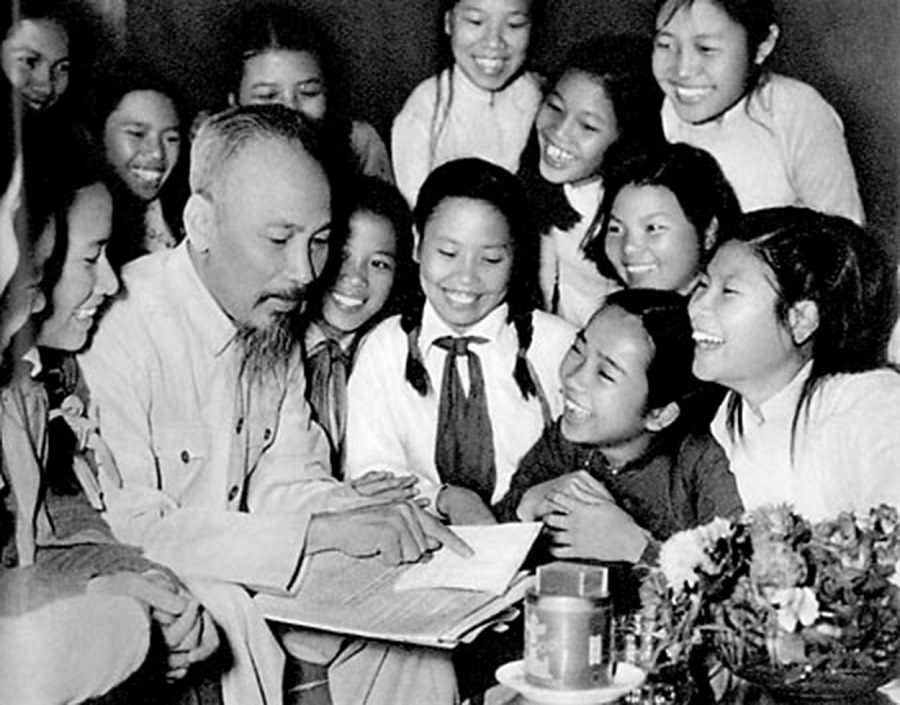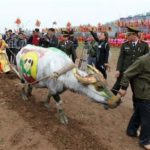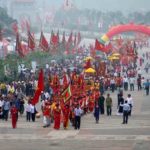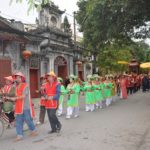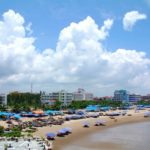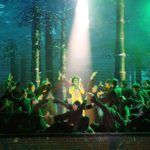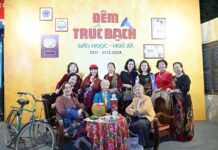The display aims to mark 35 years of UNESCO’s Resolution honoring President Ho Chi Minh as a Hero of National Liberation and a Great Man of Culture of Vietnam and the 68th anniversary of the Liberation Day of the Capital (October 10, 1954 – October 10, 2022).
President Ho Chi Minh’s great love for Hanoi
| These pupils from Trung Vuong School in Hanoi visited President Ho Chi Minh on the occasion of his birthday in May 19, 1956. File Photo |
The exhibition features over 150 documents, photos, books, and other materials arranged under the title “President Ho Chi Minh with Hanoi Capital” on display at the Hanoi Exhibition House in Dinh Tien Hoang Street, Hanoi.
“President Ho Chi Minh with Hanoi Capital” display consists of two parts, including “President Ho Chi Minh with Hanoi” and “Memorial Monuments and Relics of President Ho Chi Minh in Vietnam and around the world”.
The exhibition’s first part introduces the public stories, photos, articles, and talks showing the late President’s concerns about Hanoi. Photographs of President Ho Chi Minh’s working trips in Hanoi are the most vivid evidence of his special care for the capital’s workers and people.
In 1955, the President visited and talked to Gia Lam Railway Factory workers. He also met pupils at Trung Vuong School in Hanoi in the same year. Later, he visited Bay Mau Park or today’s Thong Nhat Park and, with workers, planted trees at the park to open up the movement of “New Year Tree Planting” in 1960.
| President Ho Chi Minh talked to workers of the Gia Lam Railway Factory during his visit to the place in 1955. File Photo |
In addition, from 1945 to 1969, the President wrote 73 articles dedicated to the capital and the people of Hanoi.
Hanoi is also the place to mark important milestones in the career of President Ho Chi Minh.
Some pictures, artefacts, and documents related to the house at 48 Hang Ngang Street, where the President drafted the Declaration of Independence, establishing the Democratic Republic of Vietnam, and other valuable materials are also displayed at the exhibition.
The exhibition’s second part, “Memorial Monuments and Relics of President Ho Chi Minh in Vietnam and around the world, ” shows the Vietnamese and international friends’ deep respect for President Ho Chi Minh.
| President Ho Chi Minh Mausoleum. Photo: VNA |
The typical relics include President Ho Chi Minh’s memorial area at the Presidential Palace, the K9 Da Chong relic site, Ho Chi Minh Mausoleum and Ba Dinh Square, among others.
Meanwhile, 35 constructions and monuments of President Ho Chi Minh have been built in 22 countries. The relic sites promote mutual understanding, solidarity, and friendship, as well as deepen relations between Vietnam and other countries.
The exhibition is scheduled to last until October 13.
The history of the stone steles
As part of the series of activities to celebrate the 68th anniversary of the Liberation Day of the Capital, a thematic display entitled “Storytelling Stone” is open to the public at the Temple of Literature.
The display consists of four parts, introducing the history of Vietnam’s examinations from 1442 -1529; the great loyalties for those who pass the exams; exemplary celebrities; and old ideologies that promote the value of education and the use of talents of the governors.
| The stone doctoral steles at the Temple of Literature. Photo courtesy of the relic site |
The 82 doctoral steles recording the royal examinations held under the Le-Mac dynasties (1442-1779) that are placed at Van Mieu (the Temple of Literature) and Quoc Tu Giam (Vietnam’s first national university) are considered national treasures.
Being carved in the form of a tortoise-mounted tablet, these steles elicited the traditional symbol of longevity in Vietnamese culture. The stone steles with epitaphs composed by cultural celebrities and bright scholars of the country can be seen as pieces of art and are considered “stone history sets” about Vietnam’s Confucian education.
According to cultural experts, the inscriptions of these steles are standard Chinese verses and lines with parallel construction, which are remarkable pieces of literature and valuable in terms of art and ideology.
Tran Thi Van Anh, the Deputy Director of the Hanoi Department of Culture and Sports, affirmed that these valuable doctoral steles and other materials telling exciting stories about the life and career of more than 1,300 doctors should be continuously deciphered and widely introduced to the public.
| Foreign visitors to the Temple of Literature. Photo courtesy of the relic site |
Temple of Literature is considered the first university of Vietnam, established in 1070-1076 under the Ly Dynasty (1010-1225).
After many royal examinations, in 1482, King Le Thanh Tong, who reigned from 1460 to 1497, ordered the erection of stone steles inscribed with the names and native lands of the first laureates of the royal examinations since the royal examinations began in 1442.

